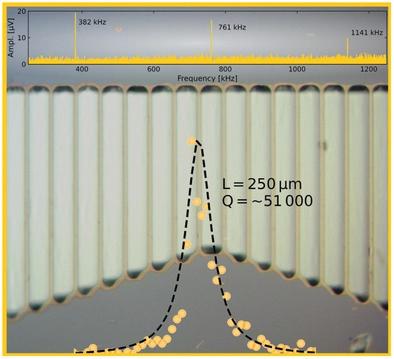Our official English website, www.x-mol.net, welcomes your feedback! (Note: you will need to create a separate account there.)
Stress Analysis and Q-Factor of Free-Standing (La,Sr)MnO3 Oxide Resonators
Small ( IF 13.3 ) Pub Date : 2022-08-05 , DOI: 10.1002/smll.202202768 Nicola Manca 1 , Federico Remaggi 1, 2 , Alejandro E Plaza 1 , Lucia Varbaro 2 , Cristina Bernini 1 , Luca Pellegrino 1 , Daniele Marré 1, 2
Small ( IF 13.3 ) Pub Date : 2022-08-05 , DOI: 10.1002/smll.202202768 Nicola Manca 1 , Federico Remaggi 1, 2 , Alejandro E Plaza 1 , Lucia Varbaro 2 , Cristina Bernini 1 , Luca Pellegrino 1 , Daniele Marré 1, 2
Affiliation

|
High-sensitivity nanomechanical sensors are mostly based on silicon technology and related materials. The use of functional materials, such as complex oxides having strong interplay between structural, electronic, and magnetic properties, may open possibilities for developing new mechanical transduction schemes and for further enhancement of the device performances. The integration of these materials into micro/nano-electro-mechanical systems (MEMS/NEMS) is still at its very beginning and critical basic aspects related to the stress state and the quality factors of mechanical resonators made from epitaxial oxide thin films need to be investigated. Here, suspended micro-bridges are realized from single-crystal thin films of (La0.7,Sr0.3)MnO3 (LSMO), a prototypical complex oxide showing ferromagnetic ground state at room temperature. These devices are characterized in terms of resonance frequency, stress state, and Q-factor. LSMO resonators are highly stressed, with a maximum value of ≈260 MPa. The temperature dependence of their mechanical resonance is discussed considering both thermal strain and the temperature-dependent Young's modulus. The measured Q-factors reach few tens of thousands at room temperature, with indications of further improvements by optimizing the fabrication protocols. These results demonstrate that complex oxides are suitable to realize high Q-factor mechanical resonators, paving the way toward the development of full-oxide MEMS/NEMS sensors.
中文翻译:

独立式 (La,Sr)MnO3 氧化物谐振器的应力分析和 Q 因子
高灵敏度纳米机械传感器大多基于硅技术和相关材料。功能材料的使用,例如在结构、电子和磁性之间具有强烈相互作用的复合氧化物,可能为开发新的机械转换方案和进一步提高器件性能开辟了可能性。将这些材料集成到微/纳米机电系统 (MEMS/NEMS) 中仍处于起步阶段,与应力状态和由外延氧化物薄膜制成的机械谐振器的品质因数相关的关键基本方面需要进行了调查。在这里,悬浮微桥是由(La 0.7 ,Sr 0.3 )MnO 3的单晶薄膜实现的(LSMO),一种在室温下呈现铁磁基态的原型复合氧化物。这些器件的特征在于谐振频率、应力状态和 Q 因子。LSMO 谐振器承受高应力,最大值约为 260 MPa。考虑到热应变和与温度相关的杨氏模量,讨论了它们的机械共振的温度依赖性。测得的 Q 因子在室温下达到数万,表明通过优化制造协议可以进一步改进。这些结果表明,复合氧化物适用于实现高 Q 因子机械谐振器,为全氧化物 MEMS/NEMS 传感器的发展铺平了道路。
更新日期:2022-08-05
中文翻译:

独立式 (La,Sr)MnO3 氧化物谐振器的应力分析和 Q 因子
高灵敏度纳米机械传感器大多基于硅技术和相关材料。功能材料的使用,例如在结构、电子和磁性之间具有强烈相互作用的复合氧化物,可能为开发新的机械转换方案和进一步提高器件性能开辟了可能性。将这些材料集成到微/纳米机电系统 (MEMS/NEMS) 中仍处于起步阶段,与应力状态和由外延氧化物薄膜制成的机械谐振器的品质因数相关的关键基本方面需要进行了调查。在这里,悬浮微桥是由(La 0.7 ,Sr 0.3 )MnO 3的单晶薄膜实现的(LSMO),一种在室温下呈现铁磁基态的原型复合氧化物。这些器件的特征在于谐振频率、应力状态和 Q 因子。LSMO 谐振器承受高应力,最大值约为 260 MPa。考虑到热应变和与温度相关的杨氏模量,讨论了它们的机械共振的温度依赖性。测得的 Q 因子在室温下达到数万,表明通过优化制造协议可以进一步改进。这些结果表明,复合氧化物适用于实现高 Q 因子机械谐振器,为全氧化物 MEMS/NEMS 传感器的发展铺平了道路。



























 京公网安备 11010802027423号
京公网安备 11010802027423号